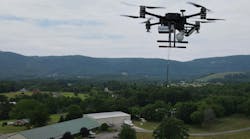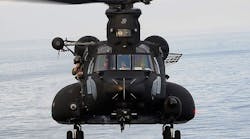By John McHale
BALTIMORE — The U.S. Air Force F-16 jet fighter is getting a radar facelift with RACE multiprocessor technology from Mercury Computer Systems in Chelmsford, Mass.
Integrating the RACE parallel-processing computer fabric into the F-16 radar system are avionics designers from the Northrop Grumman Electronic Sensors and Systems Sector (ES3) in Baltimore.
Northrop Grumman experts are supporting the F-16's advanced agile beam fire control radar and the internal forward-looking infrared and targeting system.
Northrop Grumman engineers are using Mercury's 6U PowerPC AltiVec processor board with RACE ++ architecture. RACE++ is the next generation of the RACE switched fabric architecture that increases the aggregate bandwidth of RACE crossbars from 480 megabytes per second to 1 gigabyte per second.
"Northrop Grumman is continuing to innovate in the adaptation of commercial off-the-shelf (COTS) products for advanced radar systems," says James Armitage, vice president of engineering at Northrop Grumman ES3. "Mercury delivers powerful signal processing systems that are vital in providing our airborne surveillance customers with a war-fighting edge."
"Mercury will provide the benefits of our commercial RACE architecture, and Northrop Grumman will provide the ruggedization and support required for a deployed, tactical aircraft," says Vince Mancuso, vice president and general manager of Mercury's Government Electronics Group. "It is a fundamentally a rugged version of our standard product."
This job marks the second time Mercury systems have been used on a tactical fighter, and the performance advantages of COTS is the reason for it, Mancuso says. The first was for an Ericcson radar application on the Swedish Saab Gripen fighter, he notes.
Mercury's digital signal and image processing technology and architecture will power the F-16's advanced agile beam fire control radar and internal forward-looking infrared and targeting system, Mercury officials say.
The agile beam radar helps pilots continuously search for and track multiple targets. As a result of increased operational flexibility, pilots will have the ability simultaneously to perform air-to-air search-and-track, air-to-ground targeting, and aircraft terrain following.
Agile beam radar has a programmable, modular architecture that has proven to be reliable under extreme weather conditions and under a broad range of threats.
Other advantages of this radar include a large detection range, an ability simultaneously to detect and track multiple targets, high-resolution synthetic aperture radar (SAR) imaging, and a twofold increase in reliability compared to conventional, mechanically scanned radar, Mercury officials explain.
The F-16 will constitute 56 percent of the U.S. Air Force's fighter force through year 2010, about the time the Joint Strike Fighter production is anticipated to ramp up, Mercury officials say. The F-16 constitutes a significant portion of NATO's fighter force with more than 800 aircraft in European air forces, including recent orders for 80 aircraft from the United Arab Emirates (UAE) and 50 from Greece.
Engineers at Northrop Grumman's ES3 division have also chosen Mercury's RACE systems for several of their other applications including: the Tactical Endurance Synthetic Aperture Radar (TESAR) system, a lightweight, low-cost surveillance radar that works with an associated ground station to produce photographic-quality radar imagery with one-foot resolution; and the Space-Time Adaptive Processing (STAP) system, a 972-processor system that improves the detection of difficult or concealed targets in real time, Mercury officials say.


